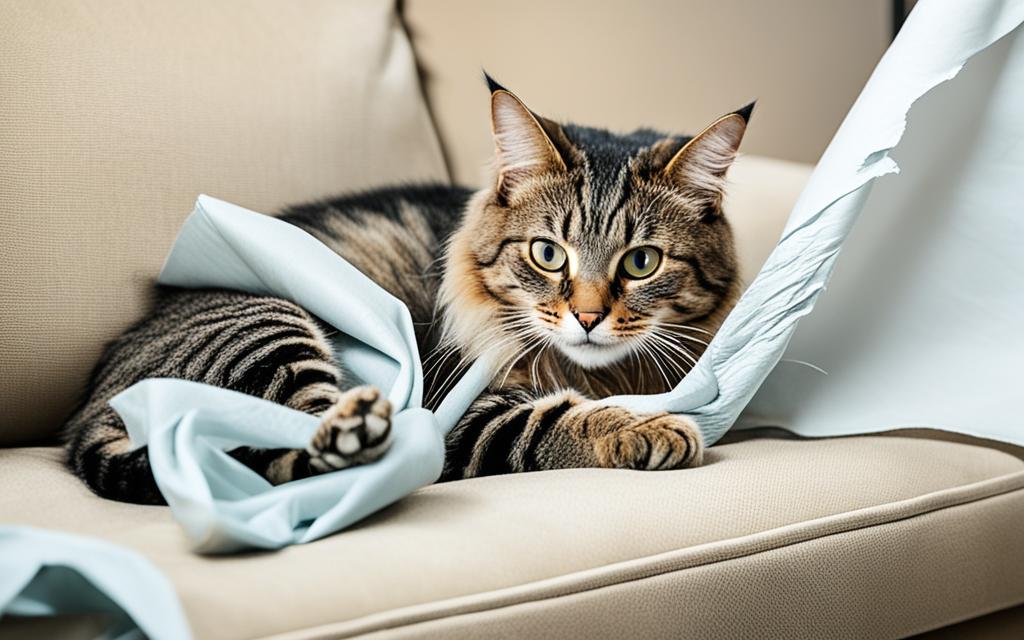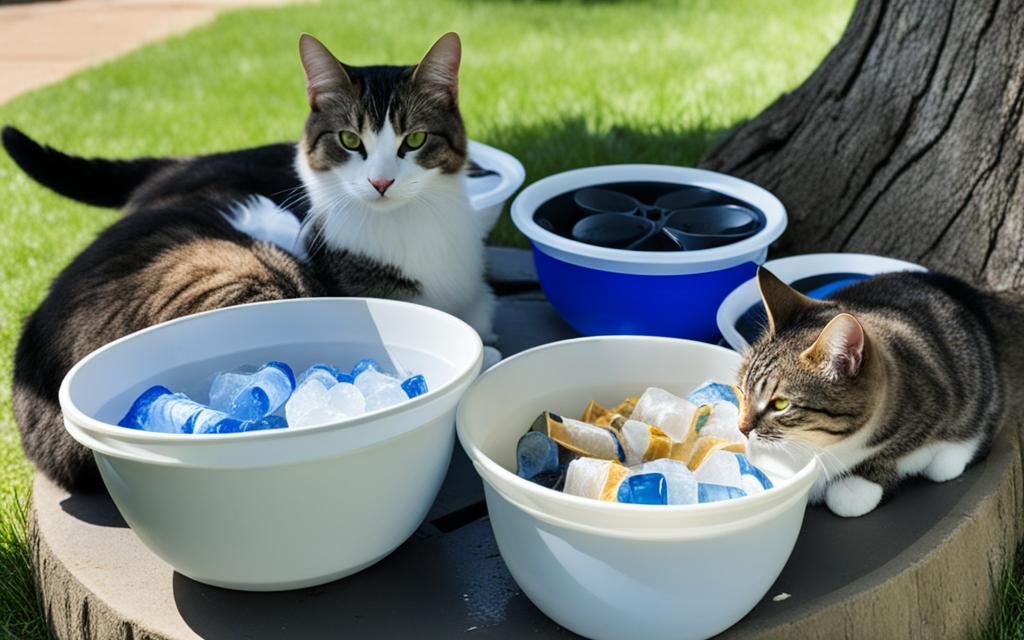How to Stop Cat From Scratching Couch

How to Stop Cat From Scratching Couch – Scratching is healthy for cats. They need to scratch. But, you can keep them off your couch. Understand why cats scratch. Then, find them other things to scratch.
This will help protect your furniture. You can make your couch less attractive to them. By doing this, you and your cat can both be happy.
Understanding Why Cats Scratch
Cats scratch for various reasons. These are linked to their natural behaviors and needs. Knowing this helps us guide their scratching without harm to our belongings.
Claw Health and Shedding
Cats scratch to keep their claws healthy. This helps them remove old claw layers, keeping their claws sharp. It’s an important part of their grooming.
Exercise and Play
Scratching is also a good workout for cats. It lets them stretch and use many muscles. Plus, cats enjoy it as a form of play and interaction with their world.
Territorial Marking
Cats mark their territory through scratching. They do this to feel secure, using both visual and smell cues. It’s a key part of their natural behavior.
Mental and Emotional Well-being
For cats, scratching isn’t just physical. It’s also crucial for their mental health. Preventing them from scratching can lead to stress. Providing the right scratching spots is essential for their well-being.
Understanding why cats scratch helps us find positive solutions. This way, both you and your cat can be happy and content.
Provide Appropriate Scratching Alternatives
To stop your cat from scratching the furniture, it’s important to offer good scratching options. There are many types of scratching posts available. You can choose from vertical or horizontal designs. Also, there are toys made for scratching. You just have to look around to find what works best for your cat.
Types of Scratching Posts
Vertical posts are a top pick. They let cats stretch out fully to scratch up high. If your cat likes a challenge, this is a good choice. On the flip side, some cats prefer to scratch closer to the ground. For them, horizontal posts are better.
Scratching Post Materials
What the post is made of can affect your cat’s choice. Posts can be covered in sisal rope, corrugated cardboard, or natural wood. Sisal feels rough and is great for clawing. Cardboard and wood let cats scratch in different ways. Try out a few kinds to see what your cat enjoys the most.
Ideal Post Length and Placement
When picking a post, think about your cat’s size and how they like to scratch. Taller vertical posts are good for cats who like to stretch. For cats in tight spaces, a shorter post placed horizontally works better. Make sure the post is near the furniture they are targeting.
By choosing the right scratching posts and placing them well, you can save your furniture. It might take a few tries to find what your cat loves. But, with patience, you’ll discover the best scratching post for your pet.
Make Your Furniture Less Appealing
Making your furniture less attractive to your cat can be done in a few ways. You can cover it with materials like sheets, plastic, or aluminum foil. These coverings make it hard for your feline to scratch where it shouldn’t.
Cover with Protective Materials
Put protective layers on the furniture to make it less tempting for your cat. Sheets, plastic covers, or foil can be great for this. These items create a barrier that your cat won’t like scratching.
Use Double-Sided Sticky Tape
Place double-sided sticky tape on furniture to deter cat scratching. The sticky feel is uncomfortable for your cat. They will likely choose a different spot to scratch.
Apply Deterrent Scents
You can also use certain smells to keep your cat away from furniture. Spraying safe but foul scents on the furniture works. Mix this tactic with materials and new scratching spots to get better results.
Pair these methods with giving your cat alternative items to scratch. This teaches your cat where it can and can’t scratch. With time, they will focus their clawing on the right places.
Keep Your Cat’s Nails Trimmed
Trimming a cat’s nails regularly can stop them from ruining furniture by scratching. Most cats keep their nails in good shape, but some may need help, such as old or sick cats. The best time to start is when they are young. This way, they learn to be okay with nail trimming.
Introduce Nail Trimming Gradually
Teaching your cat about nail trimming slowly can make it easier for both of you. Start by gently handling their paws. Reward them with treats and praise. Gradually move on to holding their paws and extending the claws. Always make sure it’s a positive experience for them. This step-by-step approach will help make nail trimming less scary for your cat.
Proper Nail Trimming Technique
While trimming their nails, use special clippers made for cats. Snip only the clear part of the nail. Be careful not to cut into the pink quick where the blood vessels are. This method ensures a safe and pain-free nail trim. It’s best to trim their nails every 2-4 weeks to keep them blunt and reduce furniture damage.
If your cat doesn’t like getting their nails trimmed, don’t worry. You can have a professional, like a vet or a groomer, do it for you.
Consider Claw Caps or Covers
Do you have a cat that loves to scratch everything? Consider using claw caps or soft paws. These are rubber caps that cover your cat’s claws. They prevent your cat from destroying your furniture. Yet, remember to check and change them every few weeks. This is because a cat’s claws keep growing.
Choosing claw caps is better than choosing declawing. Declawing is a surgery that removes a cat’s claw. It’s very painful and not good for the cat long term. By using claw caps, your cat can scratch without any harm. Your cat stays happy but your furniture is safe too.

how to stop cat from scratching couch
Stopping your cat from scratching the couch means finding better spots for them to scratch. Start with placing strong, attractive scratching posts close to their favorite scratching spots. Use catnip on the posts or hang toys to grab their interest.
Redirect to Scratching Posts
Scratching posts are a great choice to keep your cat off the furniture. Make sure to have different kinds, like vertical and horizontal ones, and scratching toys. Put them where your cat usually scratches. This change can get them to use the posts instead.
Use Deterrents on Furniture
To keep the couch safe, try making it uninviting. Use things like double-sided tape or citrus smells. This can stop your cat from scratching there while they learn to love their scratching posts.
Provide Appropriate Scratching Outlets
By giving your cat good scratching options and making your furniture less attractive, you can teach them where to scratch. Use these tips together to protect your couch and keep your cat happy.
Never Declaw Your Cat
Declawing is a surgery that should be off-limits. It cuts off a cat’s toe knuckles, causing ongoing pain. This leads to issues like avoiding the litter box, more aggression, and trouble moving around.
Risks and Consequences of Declawing
Declawing cats has serious and clear risks. It causes immediate pain and forever changes how their paws feel. This can lead to walking differently and a higher chance of arthritis. Without claws, cats miss out on natural scratching, which keeps their claws healthy and marks their territory.
Ethical Concerns
Declawing isn’t just about health issues. It hits at moral problems too. Cats need their claws for defense, climbing, and feeling safe. Taking away this key part of their bodies is seen as cruel and has led to bans in some places. This includes parts of the U.S. and other countries.
Instead of declawing, look for kind ways to deal with scratching. This includes giving them good places to scratch, using safe ways to stop them from ruining furniture, and keeping their nails short. This way, you can keep your home nice without ignoring your cat’s natural instincts and needs.
Combine Multiple Strategies
To stop your cat from scratching the couch, try several strategies at once. This could mean getting the right scratching posts, making the sofa less tempting, and more. By mixing different tactics, you and your cat can both be happy.
Consistency and Patience
Being consistent and patient is vital when teaching cats not to scratch furniture. It might take a while for them to pick up new habits. Stick to your plan and stay positive. Treats and praise for using the right posts can speed up learning.
Positive Reinforcement
It’s key to reward your cat when they scratch the right areas. Use treats or kind words to show them they’re doing well. This is far better than yelling at them. It keeps your relationship strong and helps them learn faster.
Accepting Occasional Scratching
It’s normal for cats to scratch sometimes. Instead of trying to stop all scratching, pick a piece of furniture for it. This could be an old chair or sofa. Let your cat have fun scratching there.
Understand that some damage is okay. By doing this, you won’t fight with your cat all the time.
Designating a “Scratch-Friendly” Piece
Choose a piece of furniture where scratching is allowed. This keeps your home peaceful. Cats need to scratch, but they can learn where it’s okay.
Managing Expectations
Learn to live with your cat’s scratching. Even with a special piece, they might try other places. But, be patient. Understand that scratching is natural for them.
Conclusion
To stop your cat from scratching the couch, you need a few steps. Understand why they scratch, give them better things to scratch, make the sofa less good for scratching, and use friendly training methods. Doing this with care and effort can save your furniture and keep your cat happy. Patience, doing the same things, and teaching with rewards are the keys to success.
A little scratching now and then is normal, so be ready for it. Focus on where it’s okay for them to scratch. This way, you and your cat can be happy together without damaging your home. Always remember the tips for preventing cat scratching and the ways you can stop them from clawing the furniture.
Use different methods like getting a scratch post and making the couch less attractive. Being creative and sticking to your plan can save your favorite sitting places. This way, your house stays nice, and your cat stays content.





